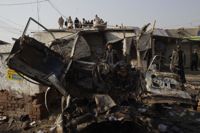PAKISTAN: Taliban Bombs Get Deadlier

In their efforts to kill and injure more people as part of a terror campaign in northern Pakistan, the Taliban militia have resorted to lacing bombs with toxic chemicals that leave survivors with complicated wounds.
'The new techniques devised by the militants are designed to inflict complicated injuries on the survivors of the bombings and suicide attacks. They develop contractures and physical deformities,' said Muhammad Tahzeebullah a surgeon at the Lady Reading Hospital in Peshawar.
The Taliban have bomb experts who manufacture explosives that cause grievous injuries, he said. 'In the last two years, we have noticed that the victims end up developing more complications and disabilities.'
Khalid Khan, an official of the bomb disposal squad, said the Taliban have created special manuals for bomb making which are used in their schools in the Federally Administered Tribal Areas (FATA). One manual lists the equipment needed to build a bomb factory.
'Camps which impart training to the suicide bombers and others to plant explosives in designated places have developed manuals of bomb-making scripted in Pashto, Urdu, Persian and Arabic which explain how to get ingredients and make explosives,' he said.
Khan said that the easy availability of incendiary materials like magnesium, potassium and sodium have made the Taliban’s work easier, and they now have expertise in mixing chemicals into bombs to cause serious injuries.
Only 10 percent of those injured in Taliban attacks survive, usually with crippling deformities and injuries, he said.
Pakistan has lost 35,000 people, including 5,000 soldiers, in bombings and suicide attacks unleashed by Taliban militants after they fled to the FATA from neighbouring Afghanistan, when that country was invaded by United States-led forces in late 2001.
By mid-2005, the Taliban had taken to attacking government forces and targeting marketplaces, CD and music shops and Internet cafes. Of late, they have begun attacking mosques and funeral ceremonies to kill as many people as possible.
Last year, the U.S. froze 700 million dollars in aid to Pakistan, seeking the latter’s cooperation in stopping the spread of homemade bombs, or improvised explosive devices (IEDs) - the militants' most effective weapons against U.S.-led coalition troops in Afghanistan.
Mixing potassium, nitrogen, sugar, urea and glycerine in explosives causes complex and compound injuries, said Prof. Nasir Shah at the Bannu Medical College. The insurgents have gained expertise in making the explosives deadlier than before, he said.
Omar Ali, 15, who was injured in a suicide attack in August last year, is one of those who may die a lingering death from complex injuries. 'His wounds looked normal but the chemicals mixed into the explosives have caused septicemia and he is likely to die,' Dr. Jamil Anwar at the surgical ward of Hayatabad Medical Complex (HMC) said.
'The only way to minimise the chances of deep infection is to rush the blast victims to the hospitals as soon as possible and ensure that the wounds are thoroughly cleaned,' the surgeon told IPS.
However, most victims are transported to hospitals late, allowing the toxic chemicals to penetrate deep and cause severe damage or infections, Anwar said. Injuries from firearms and road accidents, even severe ones, are easier to treat than those caused by Taliban bombings, he said.
Tariq Khan, a plastic surgeon at the Khyber Teaching Hospital in Peshawar says phosphorous-based explosives are the worst, especially when used in homemade bombs.
'Burn wounds of normal nature respond to antibiotics, but injuries caused by homemade nitrogen and potassium-based explosives are incurable and the victims often die even if they have only 10 percent injuries on their bodies,' he says.
Dr. Sirajuddin Syed at the Accident and Emergency Department at Lady Reading Hospital in Peshawar said bombs produce carbon monoxide that retards the oxygen-binding capacity of blood. 'The smoke from these explosives penetrates the body and retard the oxygen-carrying process, due to which the patients go into a coma and die.
'Since 2005, we have admitted 1,319 people wounded by terrorist bombings and 50 percent of them died,' Syed said. 'In our experience wounds caused by gunpowder and shrapnel are curable, but not the ones caused by the Taliban’s bombs.'
In response to the insurgents’ strategy, a state-of-the-art trauma centre is now being built at the HMC at a cost of 11.5 million dollars to treat victims of terrorist attacks in Afghanistan and Pakistan.
The 120-bed Benazir Bhutto Shaheed Burn, Trauma and Reconstructive Ward, named after the former prime minister, killed in a bombing attack in December 2007, will solely treat Afghans and Pakistanis who suffer burns and injuries in bombings and suicide attacks.
© Inter Press Service (2012) — All Rights ReservedOriginal source: Inter Press Service
 Global Issues
Global Issues